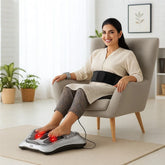Diabetes is a chronic condition that affects millions of people worldwide. Among the many complications that can arise from diabetes, foot problems are particularly common and can be serious if not properly managed. Diabetic socks are specially designed to address the unique needs of diabetic feet, offering numerous benefits for foot care and overall health. This article will explore the advantages of using diabetic socks, providing a comprehensive guide for those looking to improve their foot health.
Diabetic socks are specially crafted to reduce the risk of foot injuries, enhance blood circulation, and keep feet dry. Unlike regular socks, they are made with specific features to cater to the needs of individuals with diabetes, including non-binding tops, seamless designs, and moisture-wicking materials.
Benefits of Diabetic Socks
1. Improved Blood Circulation
- Non-Binding Tops: Diabetic socks are designed with non-binding tops that do not constrict the legs, promoting better blood flow. This is crucial for diabetics, as poor circulation can lead to severe complications.
- Graduated Compression: Some diabetic socks offer graduated compression, which gently squeezes the leg in a way that helps blood flow back toward the heart, reducing the risk of blood clots and swelling.
2. Moisture Management
- Moisture-Wicking Materials: Diabetic socks are made from moisture-wicking materials that keep the feet dry by drawing sweat away from the skin. This helps prevent fungal infections and other moisture-related issues.
- Breathable Fabrics: The use of breathable fabrics in diabetic socks ensures that feet stay cool and dry, reducing the risk of blisters and sores.
3. Protection from Injury
- Seamless Design: Diabetic socks typically feature a seamless design, which minimizes friction and reduces the risk of blisters and ulcers. Seamless socks prevent irritation, which is particularly important for sensitive diabetic skin.
- Padded Soles: Extra padding in the soles of diabetic socks provides additional protection and cushioning, reducing the impact on the feet and lowering the risk of injury.
4. Temperature Control
- Thermal Regulation: Some diabetic socks are designed to regulate temperature, keeping feet warm in cold weather and cool in hot weather. This is beneficial for diabetics who may have impaired temperature sensation.
5. Antimicrobial Properties
- Antimicrobial Fabrics: Many diabetic socks are made with antimicrobial fabrics that help reduce the risk of infections by preventing the growth of bacteria and fungi.
6. Enhanced Comfort
- Soft Materials: Diabetic socks are made from soft, comfortable materials that are gentle on the skin, providing a comfortable fit without irritation.
- Snug Fit: The snug fit of diabetic socks helps them stay in place without sliding down, ensuring consistent protection and comfort throughout the day.
7. Prevention of Foot Ulcers
- Blister Prevention: By reducing friction and keeping the feet dry, diabetic socks help prevent blisters, which can lead to more serious foot ulcers if not managed properly.
8. Support for Foot Deformities
- Arch Support: Some diabetic socks offer additional arch support, which can be beneficial for individuals with foot deformities or those who need extra support for their arches.
How to Choose the Right Diabetic Socks
When selecting diabetic socks, consider the following factors to ensure you choose the right pair for your needs:
- Material: Look for socks made from moisture-wicking and breathable materials such as bamboo, cotton, or wool blends.
- Fit: Ensure the socks fit snugly without being too tight. They should not bunch up or cause pressure points.
- Compression Level: If you need extra support, consider socks with graduated compression. However, consult with a healthcare professional before using compression socks.
- Padding: Choose socks with extra padding if you need additional cushioning and protection.
- Length: Diabetic socks come in various lengths, including ankle, crew, and knee-high. Select the length that provides the best coverage and comfort for your needs.
- Antimicrobial Features: Consider socks with antimicrobial properties to reduce the risk of infections.
Refer - How to Use Diabetic Socks JSB BS60
FAQs
Q1: What are diabetic socks?
A1: Diabetic socks are specially designed socks that cater to the unique needs of individuals with diabetes, offering features such as non-binding tops, seamless designs, moisture-wicking materials, and extra padding.
Q2: How do diabetic socks improve blood circulation?
A2: Diabetic socks improve blood circulation through non-binding tops that do not constrict the legs and, in some cases, graduated compression that helps blood flow back toward the heart.
Q3: Why is moisture management important in diabetic socks?
A3: Moisture management is crucial because it keeps the feet dry, reducing the risk of fungal infections and other moisture-related issues that can lead to serious complications for diabetics.
Q4: Can diabetic socks prevent foot injuries?
A4: Yes, diabetic socks can prevent foot injuries by offering a seamless design that minimizes friction, extra padding for protection, and moisture-wicking materials that keep the feet dry.
Q5: Are there different types of diabetic socks?
A5: Yes, diabetic socks come in various materials, lengths, and designs. Some offer graduated compression, antimicrobial properties, and additional arch support to meet specific needs.
Q6: How do I choose the right diabetic socks?
A6: Consider factors such as material, fit, compression level, padding, length, and antimicrobial features when choosing diabetic socks. It's also advisable to consult with a healthcare professional for personalized recommendations.
Q7: Can I wear diabetic socks if I don't have diabetes?
A7: Yes, anyone can wear diabetic socks. They offer comfort, moisture management, and protection, making them suitable for individuals who want to take extra care of their feet.
Q8: How often should I replace my diabetic socks?
A8: Replace your diabetic socks as soon as they show signs of wear and tear, such as thinning, holes, or loss of elasticity. Regular replacement ensures that your feet continue to receive the necessary protection and support.
Conclusion
Diabetic socks play a vital role in foot care for individuals with diabetes. By improving blood circulation, managing moisture, protecting against injuries, and offering enhanced comfort, these socks help prevent complications and promote overall foot health. Choosing the right diabetic socks tailored to your specific needs can make a significant difference in managing diabetic foot health. Prioritize foot care with diabetic socks to enjoy the benefits of improved comfort, protection, and overall well-being.












